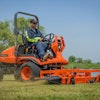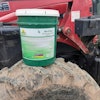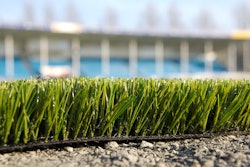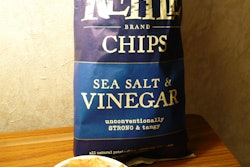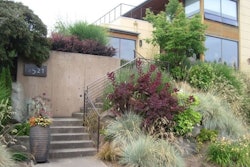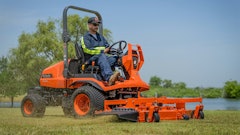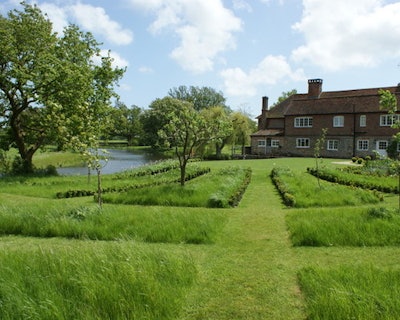
Wide grass paths are mowed in a grid through taller grass plots to create a more formal look without cutting down the entire lawn.
Insights from Falon Mihalic of Houzz
Landscapers with clients who want less-traditional lawns are actively creating beautiful alternatives with xeriscaping, perennial meadows and gardens. For those who like the look and feel of a lawn — or who live where homeowner association rules or municipal regulations require turfgrass — there are different kinds of turfgrass mixes — many of them created from native seeds, that require less water, fertilizer and mowing.
Related: How to Use Artificial Turf and Make It Look Good
The species mixes — mostly of different grasses — presented here are all different and suited to different uses. Some can handle foot traffic and pets, while others can’t. Some will do OK in shade, while others require full sun. One thing they have in common is that they are more environmentally friendly because they require less water and fertilizer to maintain.
As you consider starting or converting to a non-traditional lawn, know that there are pros and cons to having one.
Pros
- Needs less mowing, with the option to mow only once a year
- Needs no synthetic fertilizers (use compost tea or other organic lawn methods instead)
- Needs less water
- Makes an attractive, lush ground cover
- Benefits wildlife when allowed to grow long and provide habitat
Cons
- Can be more difficult to establish than traditional sod (if using seed, the establishment process is similar to creating a meadow garden)
- May be difficult to find the right product in your area
- Requires preparation for weed control if installing in an area that previously grew traditional sod
- Costs more to install than traditional sod (but you’ll get your investment back in savings from water use and more)
Related: Find an Outdoor Fountain Like This One
How to buy non-traditional grass mixes
These low-mow and low-water grasses come in several forms, and you’ll select yours depending on which species mix is available on the market and right for your climate.
Seed is the most common product available for nontraditional turfgrass mixes. Establishing a new lawn from seed is similar to establishing a prairie or meadow. Autumn is the best time to establish seed in cold climates — the seed may lay dormant through the winter and emerge in the rainy spring. Autumn and spring are the best seasons to establish seed in frost-free climates.
Plugs are available for grasses that have been selected to spread by rhizomes instead of flowering and producing seed. Plugs can be established with the help of a few simple tools and a team of friends and family. Alternatively, you can hire a landscape crew to install new plugs for your lawn. Currently, African dogtooth grass is one of the only nontraditional turfgrasses available as a plug. Some of the fescues are also available as plugs.
Sod is a mat or blanket of tightly growing grass similar to what you can buy at any hardware store but with a special mix of native grasses. Intact sod mats are the least common of the available products, but increasing demand will make sod more available on the market. Install this sod just like traditional sod.
Grasses for warm, humid climates
Warm climates are tough environments in which to grow an expanse of traditional lawn because they demand constant supplemental watering, mowing, fertilizing and weeding to maintain it. This is because traditional grass lawns are made up of cool-season grasses that grow in cooler weather. There are several species and mixes that have been developed for warm climates.
Buffalo grass (Bouteloua dactyloides) is native to the Midwest, Rocky Mountains and parts of the Southeast. It is being more commonly used as an alternative to a turf lawn because of its native status and its drought tolerance once established. Grown long, it is reminiscent of a rolling prairie. Buffalo grass likes full sun and can handle only some foot traffic. It is included in mixes but can also be used on its own.
Other mixes include little bluestem (Schizachyrium scoparium), Virginia wildrye (Elymus virginicus) and tufted hairgrass (Deschampsia cespitosa) for warm, humid climates like the Gulf Coast and southeast U.S. These grasses are commonly used as the dominant species in low-mow grass mixes.
Dog Tuff African dogtooth grass (Cynodon ‘PWIN04S’) is also available as plugs for lawns in warm, humid climates. While not a native grass, the dogtooth species is very drought-tolerant and can stand up to lots of activity, including pets and foot traffic. It likes full sun and withstands summer heat without problems.
Grasses for cool, temperate climates
Traditional grass mixes are more adapted to cool, temperate climates with sufficient moisture. However, there are still mixes on the market that are specifically created to look good with less mowing and less supplemental watering. They consist mostly of fescue species, including hard fescue (Festuca trachyphylla), sheep fescue (F. ovina) and red fescue (F. rubra). Look for products that include “low-mow” or “no-mow” in the description.
Many fescue lawn replacements are not native to the U.S., but they tolerate foot traffic and a variety of soil. They grow in full sun to part shade in cool temperate climates.
Grasses for warm, arid climates
The Lady Bird Johnson Wildflower Center has developed a no-mow, drought-tolerant mix of native grasses, called Habiturf, for gardens in Texas and the Southwest. The mix includes buffalo grass (Bouteloua dactyloides), blue grama grass (B. gracilis) and curly-mesquite (Hilaria belangeri). It requires mowing only once or twice a year and thrives in full sun. This mix can handle some foot traffic but not consistent wear and tear. It survives on a greatly reduced watering schedule compared with a traditional lawn.
Related: Sit Back and Enjoy Your Lush Lawn
Grasses for shade
Most of the species mentioned in this article require at least part sun to survive. To create an alternative lawn in shade, you can use native Carex species. Carex is a genus of sedges, or grasslike plants, with a fine texture. There are Carex species native to all regions of the United States.
Native species to consider are Pennsylvania sedge (Carex pensylvanica) for the East Coast, sanddune sedge (C. pansa) for the West Coast or Texas sedge (C. texensis) for Texas and parts of the Southwest. Choose the one that’s appropriate for your region and climate.
Eastern North American native Pennsylvania sedge grows long with a fine texture in a Philadelphia lawn.
